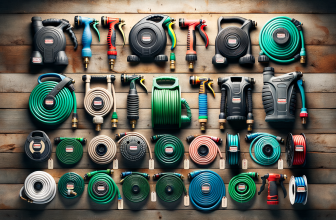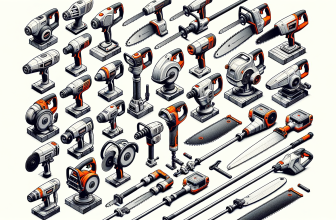
Our Top Picks
Are you on the hunt for a powerful and reliable gas chainsaw that can tackle your toughest cutting jobs? Whether you’re a homeowner with a sizeable backyard or a professional arborist, there’s a perfect gas chainsaw out there to meet your needs. To save you time and effort, we’ve scoured the market, read thousands of reviews, and garnered expert opinions. Now, without further ado, let’s dive into our top picks and find the best gas chainsaw for you.
Our #1 Top Pick: Stihl MS 271 Farm Boss
Stihl has long been a trusted name in the world of chainsaws, and the MS 271 Farm Boss is a testament to that legacy. This robust chainsaw is designed with both power and versatility in mind, suitable for various tasks from felling trees to cutting firewood. It features a 20-inch bar that can handle substantial cuts with grace and efficiency. The anti-vibration system ensures user comfort during extended use, while the tool-free fuel and oil caps make maintenance a breeze. The Farm Boss also offers an impressive power-to-weight ratio, giving you the strength needed without unnecessary bulk.
Pick #2: Husqvarna 455 Rancher
The Husqvarna 455 Rancher is another heavyweight contender in the robust world of gas chainsaws. With a 55.5cc engine and an 18-inch bar, it strikes a balance between power and maneuverability. Its X-Torq engine technology significantly reduces harmful exhaust emissions and increases fuel efficiency, which is always appreciated during long work sessions. The air injection cleaning system ensures longer operation times between filter cleans, and the LowVib feature diminishes user fatigue. This chainsaw is ideal for landowners who require a high-powered and durable tool for their wood-cutting needs.
Pick #3: Echo CS-400
If you’re looking for a lightweight option that doesn’t compromise on power, the Echo CS-400 is a fantastic choice. The 40.2cc two-stroke engine powers an 18-inch bar, making it suitable for a variety of cutting tasks. Echo chainsaws are known for their durability and this model is no exception; it’s built to handle tough conditions. The i-30 starting system greatly reduces the effort needed to start the saw, and the G-Force Engine Air Pre-Cleaner extends the life of the air filter. It’s a solid choice for consumers seeking a high-quality, user-friendly chainsaw.
Pick #4: Poulan Pro PR5020
The Poulan Pro PR5020 is a workhorse with its 50cc engine and 20-inch bar. It can tackle large trees and piles of firewood without hesitation. The OxyPower engine technology provides extra power for virtually any task, while reducing fuel consumption and emissions. An accessible purge bulb and integrated choke/stop control allow for easier starting. The user comfort during operation is addressed with reduced vibrations and an ergonomic handle. This chainsaw appeals to those who need significant power without breaking the bank.
Pick #5: Makita EA5600FRGG
Makita is another well-respected name in power tools, and their EA5600FRGG chainsaw upholds their reputation. The 56cc engine ensures plenty of cutting power and the Easy Start spring-assisted starter allows for quick and painless start-ups. It also boasts a Touch & Stop single-lever operation which is convenient for control. The magnesium housing keeps the weight down while keeping durability high. For professionals who need a dependable tool that can endure daily use, the Makita EA5600FRGG is an excellent investment.
What to Know Before You Buy
Gas chainsaws are powerful tools, but with that power comes the need for awareness and understanding. Before making your purchase, consider the following aspects:
- Engine Size: The engine’s cubic centimeter (cc) displacement influences the power output. Larger engines can handle bigger tasks, but also weigh more.
- Bar Length: This determines the size of wood you can cut through in a single pass. Longer bars can tackle large diameter wood, but make the saw heavier and less maneuverable.
- Safety Features: Look for chainsaws with safety features like a chain brake, anti-vibration systems, and safety throttle. These can prevent accidents and reduce fatigue.
- Weight: A lighter chainsaw reduces user fatigue, especially during extended use. However, weight often correlates with power, so balance these factors based on your needs.
- Ease of Maintenance: Gas chainsaws require regular maintenance. Ensure that the model you choose is straightforward to clean, and that replacing the chain and other parts doesn’t require professional help.
- Brand Reputation: Consider chainsaws from reputable brands known for their quality and customer service. This can assure you of reliability and support down the line.
Factors to Consider Before Buying
Selecting a gas chainsaw involves more than just picking the most powerful one. Keep these factors in mind to find the best fit:
- User Experience: Are you a seasoned logger or a casual user? Your experience level will influence the type of chainsaw that’s best for you in terms of power, safety features, and ergonomics.
- Purpose: Consider the primary use of your chainsaw. If you’ll be cutting large trees frequently, a more powerful saw with a longer bar might be necessary. For lighter work, a smaller, lightweight model may suffice.
- Price: Chainsaws can vary widely in price. Set a budget that reflects the quality and features you need without overspending on power or features that you’ll never use.
- Reliability and Warranty: Look for chainsaws backed by a good warranty and positive customer reviews concerning their reliability over time.
- Handling Comfort: A good chainsaw feels right in your hands. It should be balanced and have a grip that allows you to control the saw accurately and comfortably.
- Environmental Impact: Though all gas chainsaws emit fumes, look for models with cleaner technologies that minimize environmental impact.
Why Trust ChooseRight?
At ChooseRight, we take pride in providing thorough and unbiased reviews to help you make informed decisions. Our recommendations are carefully curated after hours of research, where we examine countless product specs, read through thousands of customer reviews, and seek feedback from industry professionals. Our belief is that a reliable review comes from a blend of personal testing and widespread data collection, ensuring that you’re receiving advice grounded in real-world performance and consumer experiences.
Finishing Thoughts
When it comes down to finding the best gas chainsaw for your needs, it’s clear that there’s a lot to consider. From understanding your personal requirements to weighing up the different features and capabilities of each model, the process can be as complex as it is important. Utilizing our top picks and keeping in mind the key factors to consider, you’re now equipped to make a knowledgeable choice that will serve you well in the great outdoors.
Remember, a gas chainsaw is a significant investment, not just in terms of money, but also in the quality and efficiency of your outdoor work. Ensure your final decision is one that brings ease, safety, and effectiveness to your tasks, be they professional or personal. With the right chainsaw in hand, there’s no limit to what you can accomplish.
Frequently Asked Questions
What is the best gas chainsaw for home use?
The best gas chainsaw for home use typically balances power, ease of use, and affordability. Models from reputable brands like Husqvarna, Stihl, and Echo that offer reliable performance and good ergonomics are often preferred. The specific model suitable for you would depend on the types and sizes of trees you plan to cut.
How do I determine the right size chainsaw I need?
To determine the right size chainsaw, consider the size of the wood you intend to cut. As a general rule, the chainsaw bar should be at least 2 inches longer than the wood diameter. For general home use, chainsaws with bar lengths between 14 to 20 inches are typically sufficient.
Are gas chainsaws better than electric chainsaws?
Gas chainsaws are generally more powerful than their electric counterparts, making them better for heavy-duty tasks and cutting larger trees. However, electric chainsaws are lighter, quieter, easier to start, and require less maintenance. The choice between gas and electric chainsaws depends on your specific needs and preferences.
How often should I maintain my gas chainsaw?
Regular maintenance is essential to ensure your gas chainsaw remains in good working condition. This includes checking and sharpening the chain regularly, cleaning the air filter, and replacing the spark plug as needed. It is recommended to perform basic maintenance before each use, with more thorough servicing at least once a year or as per the manufacturer’s guidelines.
What safety equipment should I wear when using a gas chainsaw?
When using a gas chainsaw, you should always wear proper safety equipment including protective eyewear, ear protection, chainsaw-safe gloves, a hard hat, steel-toed boots, and chainsaw chaps to protect your legs.
How do I properly start a gas chainsaw?
To properly start a gas chainsaw, place it on a flat surface. Engage the chain brake and follow the manufacturer’s instructions for starting, which usually involves priming the fuel, setting the choke, and pulling the start cord. Use a steady, controlled motion without excessive force. Do not attempt to start the chainsaw while holding it in the air.
What should I do if my chainsaw chain gets dull?
If your chainsaw chain gets dull, you can either sharpen it yourself using a round file size specific to your chain along with a filing guide, or you can take it to a professional for sharpening. It’s important to maintain a sharp chain to ensure efficient cutting and to reduce the risk of accidents.
Can I use any brand of chain oil with my gas chainsaw?
While you can often use different brands of chain oil with your gas chainsaw, it’s important to use oil that is designed specifically for chainsaws. Using the correct oil will ensure proper lubrication and can extend the life of your chainsaw’s bar and chain.
What is the difference between a 2-cycle and 4-cycle gas chainsaw?
A 2-cycle (or 2-stroke) gas chainsaw requires a mixture of gasoline and oil for the engine to operate, while a 4-cycle (or 4-stroke) chainsaw has a separate gasoline tank and oil reservoir. 2-cycle chainsaws are typically lighter and more compact but require a specific gas-to-oil ratio. 4-cycle chainsaws are often heavier but may be more fuel-efficient and have reduced emissions.
How do I store my gas chainsaw when it’s not in use?
When storing your gas chainsaw, drain the fuel, clean the machine thoroughly, lubricate the chain, and store it in a dry place. It’s also advisable to protect the bar and chain with a cover. Follow the manufacturer’s instructions for long-term storage to prevent issues when you next use the chainsaw.







